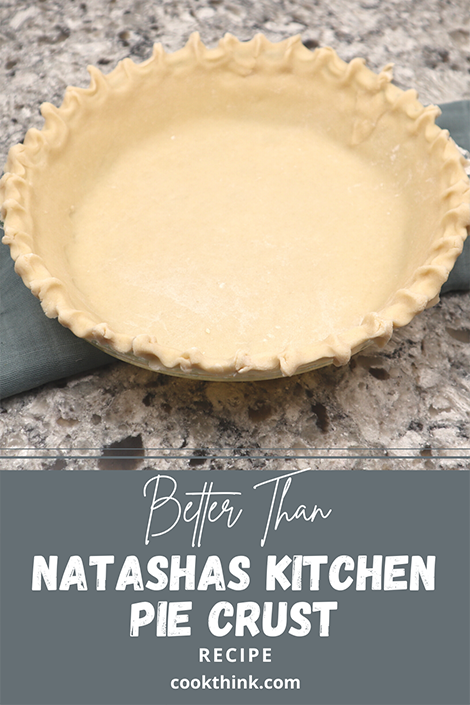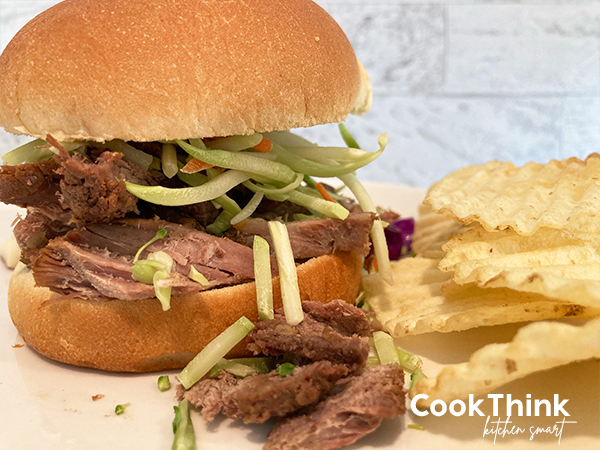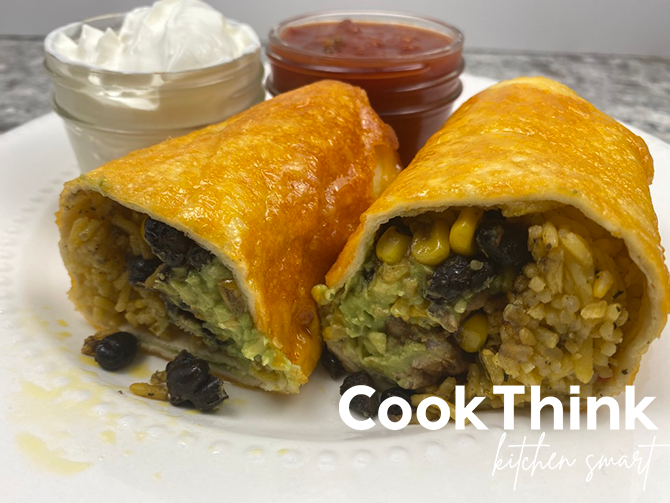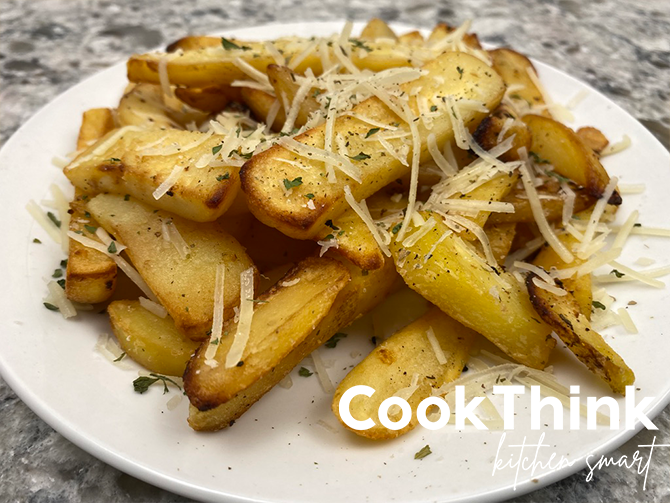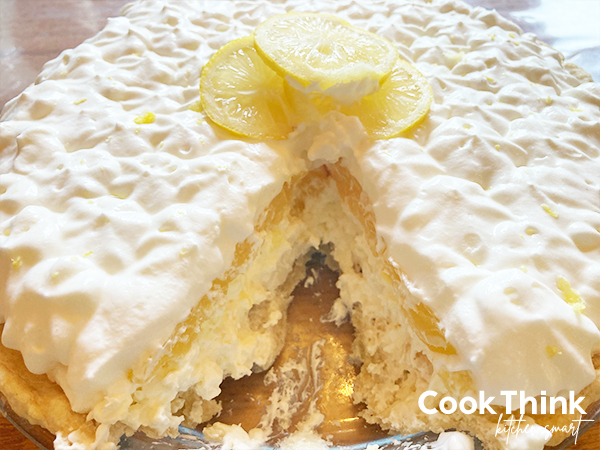Natasha’s Kitchen Pie Crust
We are excited to share a recipe with you, that we believe could rival Natashas Kitchen Pie Crust recipe. Our pie crust is made using butter, along with a few other ingredients, in a simple step-by-step process. Be sure to check out the details on how you can make this crust, as well as other helpful tips and tricks outlined below!
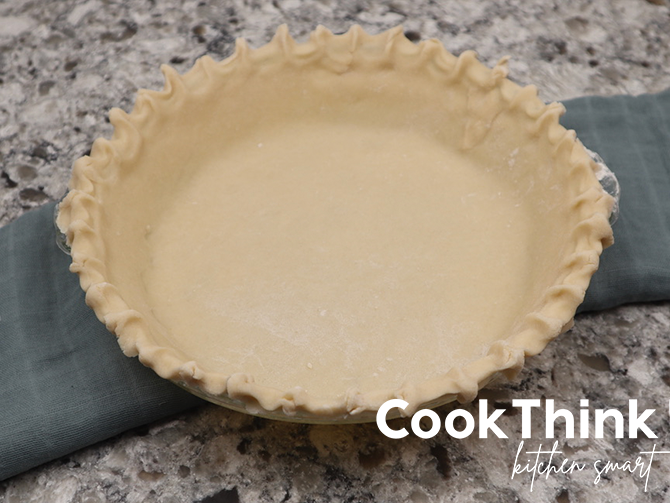
The Best All Butter Pie Crust Recipe
Although delicious, we believe that we have modified Natasha’s Kitchen pie crust recipe, to be even better. We first gave Natasha Kitchen Pie Crust recipe a try, and it turned out a bit dry and crunchy. If you prefer this type of crust, then by all means check out the original pie crust recipe, however, we are excited to share with you a modified version that will create for you the best butter pie crust recipe. It’s so easy and delicious, plus the pie crust turned out buttery and flaky, it’s oh so good!
This recipe is seriously the best butter pie crust recipe because it is foolproof to make and tastes delicious. Unlike most pie crust recipes, which are very particular to handle, this pie crust is easy to make, and tastes amazing. This is a must-try recipe for sure!
Butter Flaky Pie Crust
We have the perfect butter flaky pie crust for you. This pie crust does not require extra fussing and tastes amazing. With this butter pie crust recipe, you can say goodbye to your shortening pie crust.
Easy Pie Crust Recipe (VIDEO)
For those of you looking for an easy, no fuss, pie crust recipe, look no further this one is just for you. With this tasty butter pie crust recipe, you can easily make a delicious, and easy pie crust to fill with your desired filling.
Natashas Kitchen Pie Crust Recipe
We gave Natashas Kitchen Pie Crust recipe a try, and although it tastes good, if you like a crunchier crust, we would like to present you with a modified recipe, that is very easy to make and taste fabulous. With this recipe, you can make a delicious and flaky pie crust recipe, that works well no matter what pie filling you choose to use.
Our Favorite Tools to Make Pie:
Food Processor. One of our favorite methods to make a quick and easy pie crust is to use a food processor. However, if you do not have access to a food processor, it is not a requirement. Instead of using a food processor, you could use a pastry cutter or even a potato masher if desired.
Rolling Pin. A rolling pin is another good tool to have on hand when making a pie crust. This will allow you to roll your dough out evenly, and to your desired thickness.
Pie Plate. Anytime you are making a pie, having a pie plate on hand is a very good idea. This way, you have a dish that is deep enough and will allow you to bake your pie as desired.
Ingredients for Butter Pie Crust Dough:
All-purpose flour. Although other types of flour may be used if desired, we recommend using your basic all-purpose flour for this pie crust recipe.
Salt. When making a pie crust, we typically choose to use iodine salt, however, sea salt or kosher salt will work as well.
Butter. When making a pie crust, it is important that you use very cold butter. We typically choose to use salted butter, however, unsalted will work as well.
Water. Water is also included in making your pie crust, and it is important that your water used to be as cold as possible as well. Ice water works the best for making a delicious pie crust.
How to Make the Perfect Flaky Pie Crust:
The key to making the perfect flaky pie crust is to use cold butter, ice-cold water, and blend your mixture just until you were left with pea-sized clumps. You want to be careful to not mix your pie crust too much, as chunks of butter that are approximately pea-sized or a very good thing. Now, let’s look at how to make a homemade pie crust in four easy steps.
How to Make Homemade Pie Crust in 4 Easy Steps:
First, add your dry ingredients to your food processor. This would include your flour and salt.
Second, take your cold butter, and cut it into small cubes. Add your small cubes of butter to your food processor. Pulse for a few seconds at a time, until your mixture becomes chunked up.
Third, pour your cold water into the food processor, and pulse just until it begins to come together. With your hands, form the dough into a ball.
Finally, lightly flour a surface, and roll your dough out on the surface until it reaches your desired size. Lightly coat the top of your pie crust with flour, then carefully roll back onto the rolling pin to transfer to your pie plate. Pinch or flute the edges of your pie crust as desired.
How to Roll and Transfer Pie Dough:
When it comes to rolling and transferring your pie dough, this can be an easy, yet complicated part of your pie process. Let’s first look at the best way to roll your pie though.
How To Roll Pie Dough
When you roll out your pie dough, it is important that you first lightly flour the surface you were going to use. This means you need to take a scoop of flour, typically between ¼ to ½ cup of flour, and dust the surface lightly including the entire area that your pie crust will take up.
After your surface has been dusted with flour, place your ball of pie dough onto your lightly floured surface. Pat it down using your hand, if you’re done with sticky, you may want to sprinkle a little bit of flour on top of your dough ball as well.
Next, take your rolling pin, and roll out your pie crust until it is large enough to fit into your pie plate. Be careful to not get your crust too thin.
How To Transfer Your Pie Dough
Now that your crust is rolled to the correct size, it is time to transfer your pie dough into your pie plate. This step can get tricky, so we have a few suggestions that will hopefully help you be able to transfer the piecrust seamlessly.
Transfer With Rolling Pin. The first method used to transfer is probably one of the most used by cooks. However, if this is your first time, it may be a bit intimidating to do this method. To transfer your pie crust using a rolling pin, you’ll first want to brush the top of your pie dough with a light coating of flour.
Then, take your rolling pin and lie on top of your rolled-out pie dough. Carefully fold your pie crust around your rolling pin and roll to collect all the dough.
Once all your dough is on the rolling pin, you can pick it up, and place it over your pie plate, then gently unroll the dough from your rolling pin into the pie plate.
Transfer With Parchment Paper. Another less common method you can use to transfer your pie crust is to first dust the top of your rolled-out pie crust with flour. Then take a sheet of parchment paper and place it on top of your pie crust.
Fold the crust in half, then, add another piece of parchment paper, and fold in half again. From there, your pie crust is folded into quarters. You can then pick it up and place it on your pie plate. Then, simply unfold it in your pie plate, and remove the parchment paper.
How to Flute a Pie Crust:
Fluting a pie crust, refers to the fancy edge around the top of a pie. Fluting refers to the specific design of your pie. Although there are many ways you can finish a pie, fluting is one of the most common.
Once your pie crust is on your pie plate, you will want to trim off any excess, then fold your pie dough so that you have a slight ridge around the edge of your pie plate.
Then, to flute, the edges of your pie dough, take two fingers on the outside of your pie plate, and one finger on the inside of your pie crust. Press your finger in between your two fingers in the crust so that forms the flute shape.
If this is difficult for you to finish off your pie, you can also pinch the edge around the top using your pointer and thumb to finish off your pie. This is the method that I was taught as a young girl, and it continues to be one of my favorite ways to finish off a pie.
How to Pre-bake Pie Crust (Blindbake):
Depending on the pie you are making, you may want to use a pie crust that has been pre-baked. Four pies such as lemon meringue, strawberry, raspberry cream, and many others you will want to pre-bake the pie crust before adding your filling. The most common way to pre-bake your pie crust, is to use pie weights.

Pie Weights:
Pie weights can be purchased from many different stores. Once you have pie weights on hand, you will want to take a piece of parchment paper and place it on top of your pie crust. Then add your pie weights to the parchment paper before baking your pie crust. Pie weights are helpful, in that they help to keep your crust from moving as it bakes and prevent it from bubbling up.
*What Can I use Instead of Pie Weights?
What if you do not have pie weights, or cannot find them? There are alternatives you can use to pie weights if desired. Below are a few different ideas.
Dried beans. You want to use the same method as pie weights, in that you will line your crust with parchment paper, then pour in some dried beans. However, one downside of using dried beans, is that you will want to toss them after they have been baked.
Dried rice. Another alternative to using pie weights is to use dried rice. To use dried rice, you will also want to line your pie crust with parchment paper, then pour in dried rice before baking your pie crust.
The good thing about rice, as compared to beans, is that your rice can be used in various recipes that call for toasted rice even whereas your beans cannot.
Nothing. Nothing? That’s right. Although not recommended, you can completely skip the pie weights when baking your pie crust if you wish. One thing to know about baking your pie crust without any kind of pie weight is that you will want to poke holes into your crust before baking.
Then, you will want to check on it periodically while it is baking to make sure there are no bubbles forming. If there are bubbles, you will want to be sure to press them down so that you do not end up with a bubbly pie crust.
Butter Versus Shortening In Pie Crusts
What is better to use, butter, or shortening? This is the question and current debate as to whether butter or shortening is better to use in a pie crust.
Butter. Butter is a fantastic option to use when making pie crust. Butter is a bit more forgiving in the process of making a pie crust and has an overall better flavor to it than shortening does. However, there is the chance that your pie crust may not turn out quite as flaky as when you use shortening to make a pie crust.
Shortening. Shortening is a good option, as it typically allows your pie crust to retain its shape better as it cooks, however, the flavor is not usually as good as crusts that are made with butter. If you choose to use shortening when making your pie crust, be careful not to handle your pie crust too much and use butter-flavored shortening.
Other Options. Options such as lard and coconut oil are also possible as replacements for butter or shortening. However, butter and shortening are more common, plus they are typically better options.
Lard is very similar to shortening, only it is from pig fat.
Coconut oil, on the other hand, is another popular replacement for butter. However, if you’re going to use coconut oil, you will want to freeze the coconut oil ahead of time so that it is cold enough for a good pie crust, then you may need to increase the baking temperature of the pie crust.
How To Cut Butter Or Shortening Into Flour:
There are several different ways you can cut butter into the flour. We recommend using your food processor, or pastry cutter as these methods work the best, to get pea-sized clumps. However, you may also use a cheese grater if desired. This method really works well only if your butter is super cold or frozen.
To cut butter or shortening into flour, you will first want to take a knife, and cut your butter into small chunks. Add those small chunks to your flour mixture, then use a food processor to pulse until only pea-sized chunks remain.
When using a pastry cutter, cut the clumps of butter and flour until your butter clumps are approximately the size of a small pea. Then continue making your dough.
Make Ahead Instructions:
What if you want to make your pie crust ahead of time? This is easily done if you choose to make a pie crust ahead of time. Simply prepare your pie crust until all the ingredients are mixed. Form your dough ball, lightly flour the outside of your dough, and press it into a small patty.
Wrap the patty securely in plastic wrap, then into a sealable plastic bag. Store in the fridge, or freezer until you are ready to use. Then before using, pull the dough out and allow it to warm up before shaping and baking.
To Keep Pie From Browning Too Fast:
Often when you are baking a pie, your pie crust bakes faster than the filling. Because of this, it is important to know how to keep your pie crust from browning too fast. To prevent your pie crust from browning too fast you can simply cover the edges of your pie with foil, or cut a circle out of a piece of foil and cover your pie so that the center is still open, but the edges of your crust are covered.
Easy Pie Crust Recipe
Supplies:
Food processor or pastry cutter
Rolling pin
Measuring cup
Measuring spoon
Ingredients
2 cups all-purpose flour
½ tsp salt
1 cup very cold butter
½ cup very cold water
Instructions
Step 1
In a food processor add flour and salt. Cube butter and add to a food processor. Pulse for a few seconds until your butter is cut into pea-sized pieces.
Step 2
Add water and pulse only until combined. Roll the dough into a ball with your hands.
Step 3
Lightly flour a clean surface and roll out half of your pie dough. Transfer to a lightly greased pie plate and repeat the process with the remaining pie dough. Flute the edges of your pie crust.
Step 4
Bake or refrigerate your pie crust according to your pie instructions. If your recipe calls for a prebaked pie crust, we recommend baking this pie crust at 375°F for 10-15 minutes, or until the crust begins to turn a golden brown. Then remove from the oven and allow it to cool before adding your fillings.
Recipe Notes
Although butter tends to be more forgiving than shortening, it is still very important that you don’t play with the pie dough too much. It is also a good thing if your dough contains some butter chunks.
Natasha’s Kitchen pie crust contains different amounts of the above ingredients as well as sugar which we have chosen to leave out. Please note that this recipe is our modified version, not the original Natasha’s Kitchen Pie Crust recipe.
Nutrition Facts
One pie crust from the above recipe is estimated to contain approximately 1,269 calories in the entire pie crust. We also estimated that one whole pie crust contains 93.3g total fat, 244mg cholesterol, 1,239mg sodium, 95.5g total carbohydrates, and 13.9g protein.
Tips and Tricks for Recipe Success:
Cold Ingredients. Using cold ingredients is important to the success of your pie crust.
Minimize Handling. Another trick to a successful pie crust is to handle it as little as possible.

FAQs
Do I need a Food Processor to Make Pie Dough?
No, you do not have to use a food processor to make pie dough. You can also use a pastry cutter, to make a good pie crust.
Can I make Pie Dough in Advance?
Yes, pie dough may be made in advance if you wish. Simply prepare the dough, then pat it into patties. Wrap the dough in plastic wrap in place into a sealable bag.
What if my Pie Dough is Too Hard?
If your pie dough is too hard you can try adding additional butter, water, or even some vodka.
Why do you use vodka in your pie crust? Can I replace it with something else?
By adding vodka to the pie crust it helps to keep the gluten from making your pie crust so elastic-like. This is a good thing if your pie crust needs to be rolled out more than once. However, if you would like to substitute it, you can simply use cold water in place of vodka.
Do I have To Refrigerate The Dough?
Yes, refrigerating the dough is very important if you are not baking the crust right away as it allows the butter to chill again, making it melt quickly when baked.
Recipe Variations
Flaky Cream Cheese Pie Crust Recipe
You can also make a cream cheese pie crust by using 1 ½ stick (3/4 cup) of cold butter and 6 oz of cold cream cheese, otherwise, prepare as instructed above. For this recipe, you can also try adding 2 Tbsp of granulated sugar for an extra bit of sweetness if desired.
Filling Ideas
Apple Pie Recipe with the Best Filling
One Pot Chicken Pot Pie Recipe
Classic Quiche Lorraine (Natasha’s Kitchen)
Pecan Pie
Key Lime Pie Recipe
Strawberry Pie II
Foolproof All Butter Pie Crust
Making a butter pie crust is an easy and deliciously foolproof way to go. If you are a beginner, or experienced cook or baker making a butter pie crust is a delicious option, that is worth a try!
All Butter Pie Crust Recipe
Making an all butter pie crust recipe, it’s easy and delicious. To make a pie crust, you only need a few basic ingredients, then, simply follow our step-by-step instructions below for a delicious all butter pie crust recipe. Be sure to check out our better than Natasha’s Kitchen Pie Crust recipe above and see for yourself how delicious it is.
For more posts like this one, follow us on Pinterest, Facebook, Instagram and YouTube.
You Might Also Like
Share on Pinterest!
